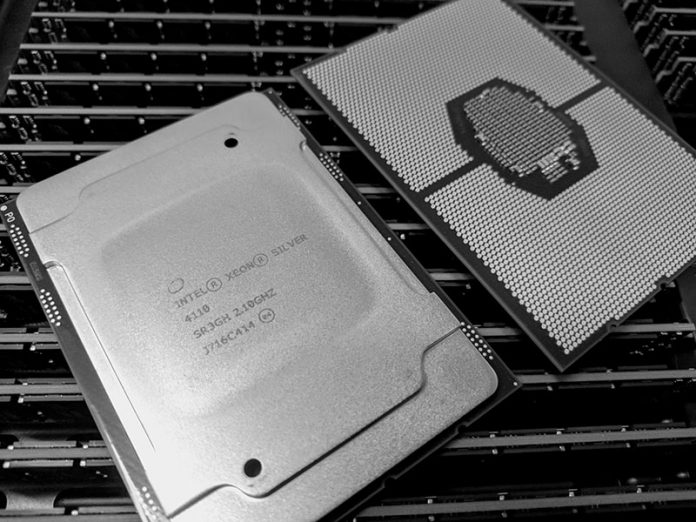If we were to discuss what a “mainstream” Intel Xeon CPU would be, we may suggest that a good starting point is the Intel Xeon Silver 4110. The Intel Xeon Silver 4110 is essentially a higher clocked version of the Intel Xeon Silver 4108 that fits the bill when you want a low cost, low power CPU. There are a large number of servers out there that want “okay” performance but do not need a ton of cores since they run applications that focus more on I/O and RAM than raw CPU performance. At the same time, the Intel Xeon Silver line offers compelling performance reasons to spend small amounts of money on incremental upgrades. Today we are benchmarking the dual processor Intel Xeon Silver 4110 configuration to see if it is worth an ~$100 premium, per CPU, over the Intel Xeon 4108 parts.
Dual Intel Xeon Silver 4110 versus Dual Intel Xeon E5-2620 V4
An Intel Xeon E5-2620 V4, the previous generation part with the same 2.1GHz base and 3.0GHz turbo clock is about 20% less expensive. It is somewhat strange to see CPUs become more costly over time. Here is the Intel ARK comparison of the two. With the Intel Xeon E5-2620 V4 one had access up to 1.5TB of RAM versus 0.75TB with the Xeon Silver 4110 even though both could handle 12 DIMMs. One gets the newer Lewisberg PCH with the Xeon Silver and 8 extra PCIe lanes. In this segment of the market, very few servers are going to use that many PCIe lanes and more than 512GB of RAM so the limitations are largely moot. Still, this is one of the easiest direct mappings between a Broadwell-EP and Skylake-SP chip we have seen.
Key stats for the Intel Xeon Silver 4110: 8 cores / 16 threads, 2.1GHz base and 3.0GHz turbo with 11MB L3 cache. The CPU features a 85W TDP. This is a price point Intel has maintained for years. Here is the ARK page with the feature set. If you want to see feature flags, here is the lscpu output of the chips.
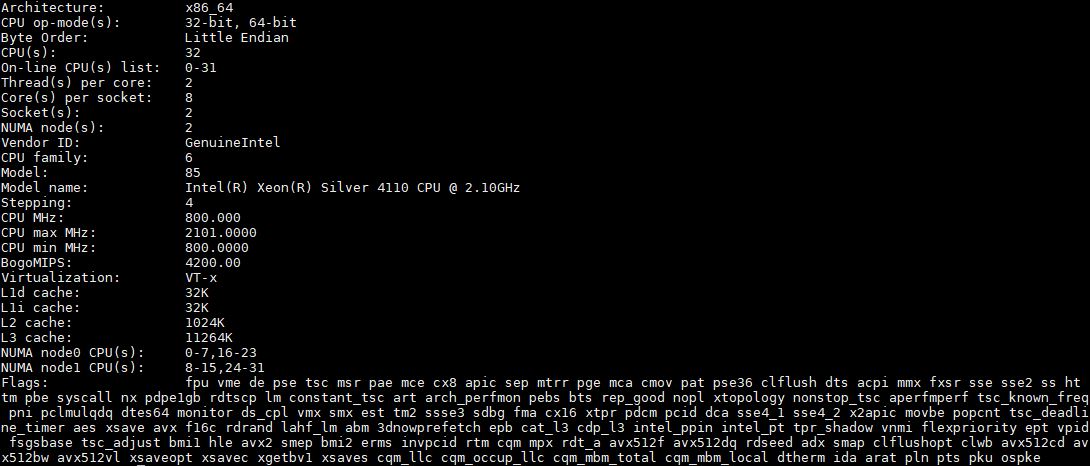
If you want to read more about the single socket performance, see our previously published Intel Xeon Silver 4110 Linux Benchmarks and Review.
Test Configuration
For this CPU review, we are using a 1U Tyan Thunder CX GT75BB7102 test platform.
- CPUs: 2x Intel Xeon Silver 4110
- System: Tyan Thunder CX GT75BB7102 1U
- RAM: 12x 16GB DDR4-2400 ECC RDIMM (Micron)
- NIC: Mellanox ConnectX-3 EN Pro 40GbE
- OS SSD: Intel DC S3700 400GB
The Tyan Thunder CX GT75BB7102 is a dual socket server that crams a surprising amount of functionality into a 1U chassis. One can put a full complement of 24x DDR4 RDIMMs along with two PCIe x16 cards, multiple OCP mezzanine cards (storage and networking) as well as use M.2 SSDs. The Intel Xeon Silver series can only utilize up to DDR4-2400 DIMMs so we are not using our DDR4-2666 in this machine.
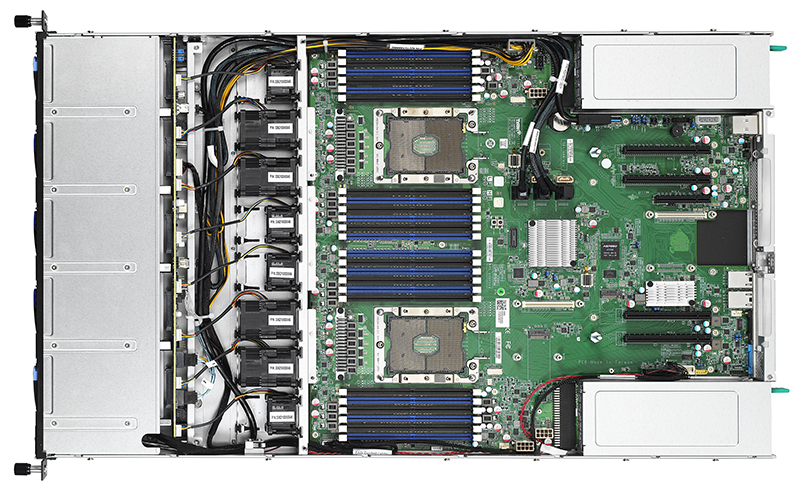
Redundant PSUs flank each side of the motherboard, and Tyan uses a novel array of fans which combine to channel cold air over the parts of the server that need it most.
In terms of storage, along with the PCIe based options, there are 10x storage bays in the front. In our test system, we are using the Intel C621 PCH SATA lanes for a low power setup. One can also use SATA DOMs on the two standard 7-pin SATA connectors.

This configuration also comes with some nice features, for example, the RJ-45 networking ports on the back of the server are 10Gbase-T Ethernet.

Overall, this is a nice platform for low power servers.
Dual Intel Xeon 4110 Benchmarks
For this exercise, we are using our legacy Linux-Bench scripts which help us see cross-platform “least common denominator” results we have been using for years as well as several results from our updated Linux-Bench2 scripts. At this point, our benchmarking sessions take days to run and we are generating well over a thousand data points. We are also running workloads for software companies that want to see how their software works on the latest hardware. As a result, this is a small sample of the data we are collecting and can share publicly. Our position is always that we are happy to provide some free data but we also have services to let companies run their own workloads in our lab, such as with our DemoEval service. What we do provide is an extremely controlled environment where we know every step is exactly the same and each run is done in a real-world data center, not a test bench.
Python Linux 4.4.2 Kernel Compile Benchmark
This is one of the most requested benchmarks for STH over the past few years. The task was simple, we have a standard configuration file, the Linux 4.4.2 kernel from kernel.org, and make the standard auto-generated configuration utilizing every thread in the system. We are expressing results in terms of compiles per hour to make the results easier to read.
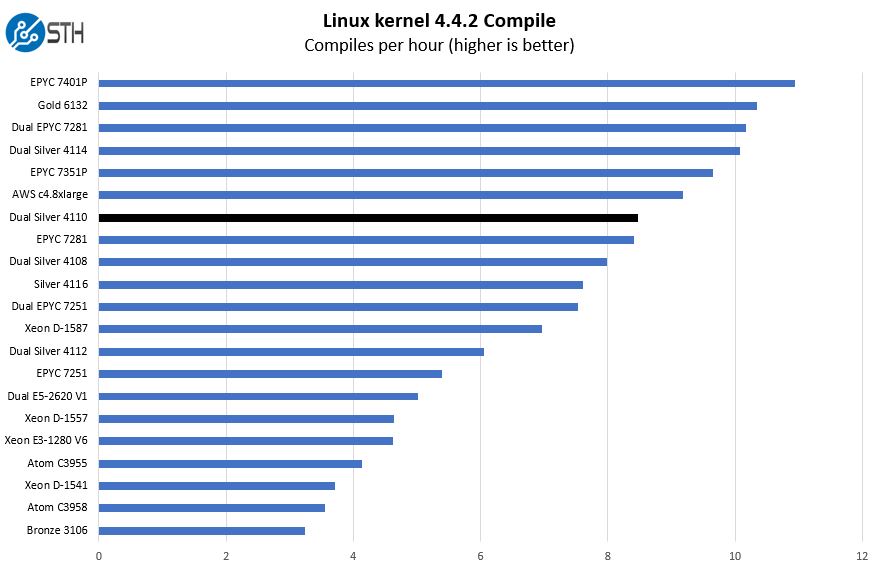
One of the key vectors to watch in this piece is the delta between the Intel Xeon Silver 4110 and dual Silver 4108 CPUs. Both have the same 85W TDP but with the higher base and turbo clocks, the Intel Xeon Silver 4110 is a significantly faster part.
c-ray 1.1 Performance
We have been using c-ray for our performance testing for years now. It is a ray tracing benchmark that is extremely popular to show differences in processors under multi-threaded workloads. We are going to use both our legacy 4K result along with our new Linux-Bench2 8K render to show differences.
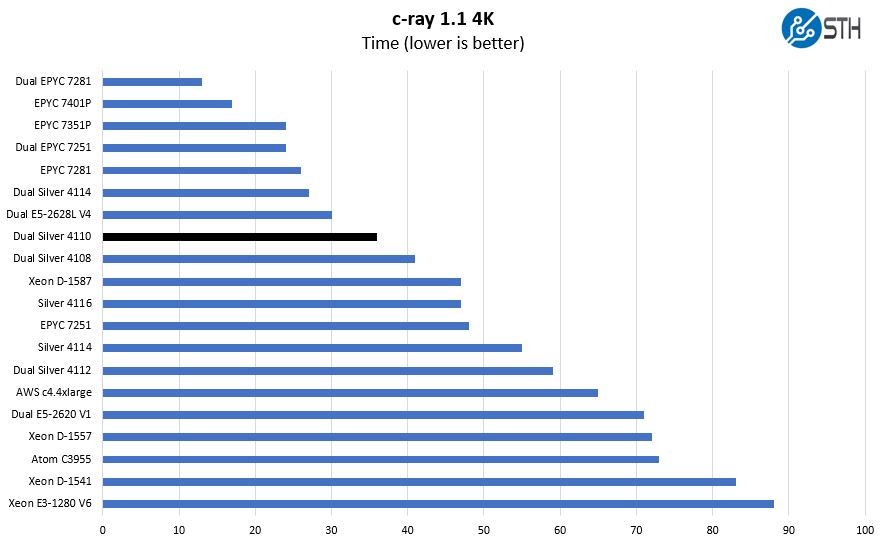
With the same core counts, we see that the dual Intel Xeon Silver 4110 and 4108 are grouped relatively close together in our charts. We see a similar pattern in the 8K results:
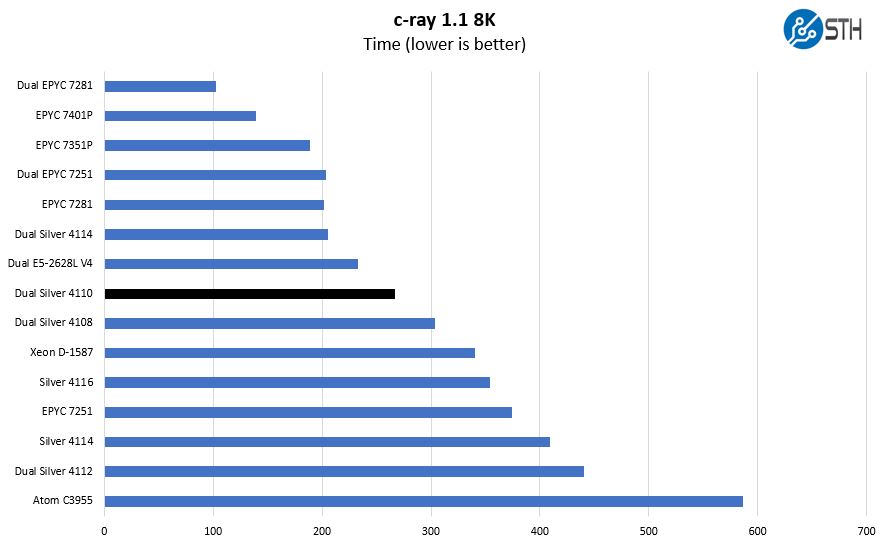
The difference between the dual Silver 4110 and 4108 is not quite as much as if one were to upgrade to a 10 core Intel Xeon Silver 4114. The dual Intel Xeon E5-2628L V4 parts are 12 core lower TDP parts from the Broadwell-EP generation so competing in a relatively similar TDP envelope at less than half the cost and with fewer (8 v. 12) cores is particularly impressive.
7-zip Compression Performance
7-zip is a widely used compression/ decompression program that works cross-platform. We started using the program during our early days with Windows testing. It is now part of Linux-Bench.
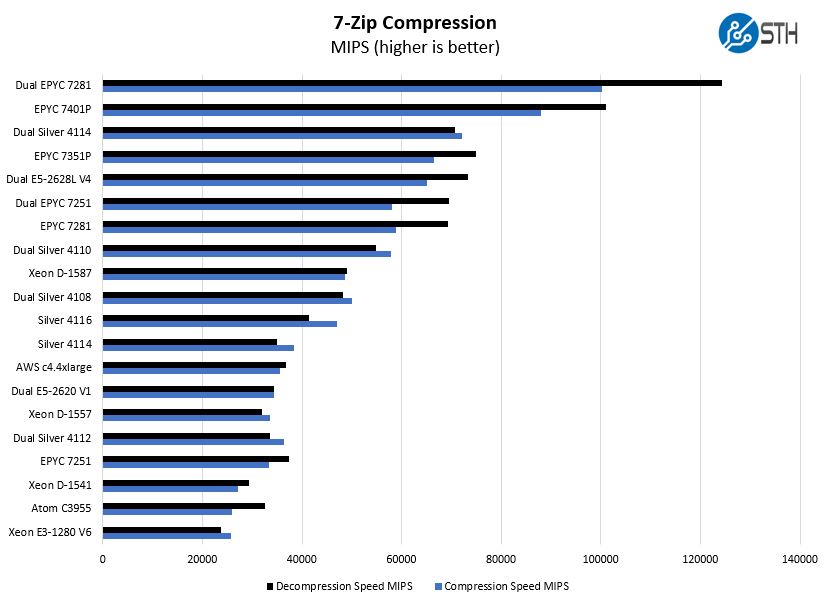
Turning our attention to the Intel Xeon D series (Broadwell-DE), one can see performance about in-line with what we are seeing from the dual Silver 4110. In memory-constrained applications, the dual Xeon Silver 4110 will do well. In applications where the UPI bus can be a bottleneck, the Intel Xeon D series can provide solid results. That is a key reason why Facebook uses Xeon D, albeit not the same retail version the public has access to.
NAMD Performance
NAMD is a molecular modeling benchmark developed by the Theoretical and Computational Biophysics Group in the Beckman Institute for Advanced Science and Technology at the University of Illinois at Urbana-Champaign. More information on the benchmark can be found here. We are going to augment this with GROMACS in the next-generation Linux-Bench in the near future. With GROMACS we have been working hard to support Intel’s Skylake AVX-512 and AVX2 supporting AMD Zen architecture. Here are the comparison results for the legacy data set:
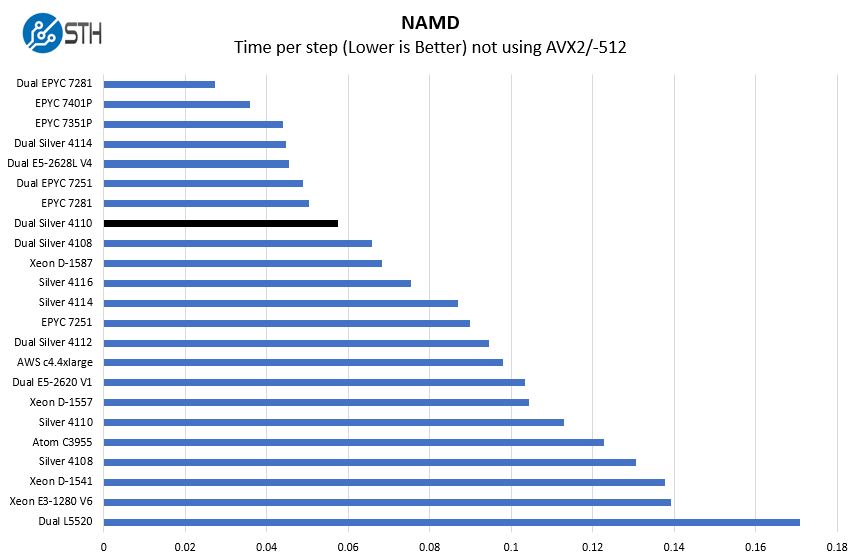
Here one can see that the overall performance is good. The other item to take note of here is that the AMD EPYC 7281 is a strong 16 core part that has higher clock speeds which allow it to perform very well against the Intel chips.
Sysbench CPU test
Sysbench is another one of those widely used Linux benchmarks. We specifically are using the CPU test, not the OLTP test that we use for some storage testing.
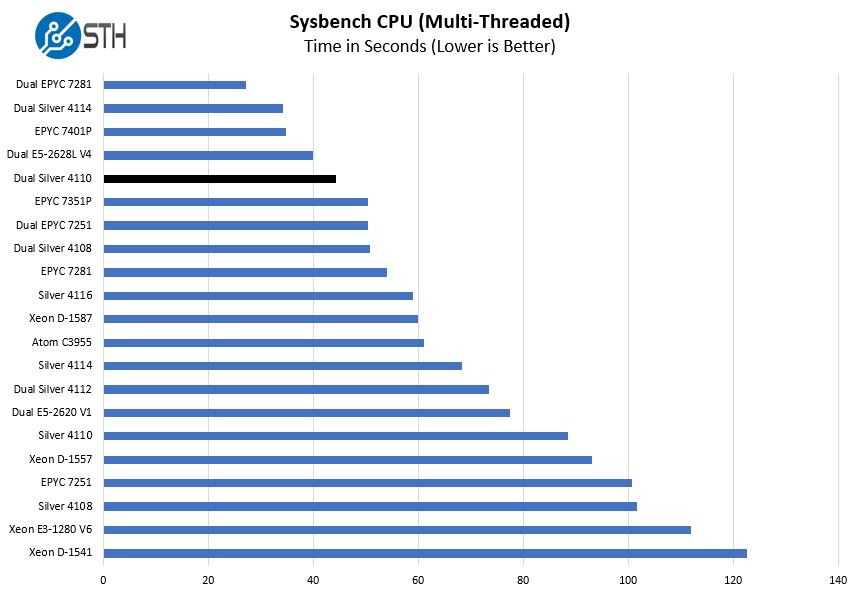
Here the dual Intel Xeon Silver 4110 CPUs actually out-perform a 16 core, higher clocked, AMD EPYC 7351P CPU which is quite an accomplishment.
OpenSSL Performance
OpenSSL is widely used to secure communications between servers. This is an important protocol in many server stacks. We first look at our sign tests:
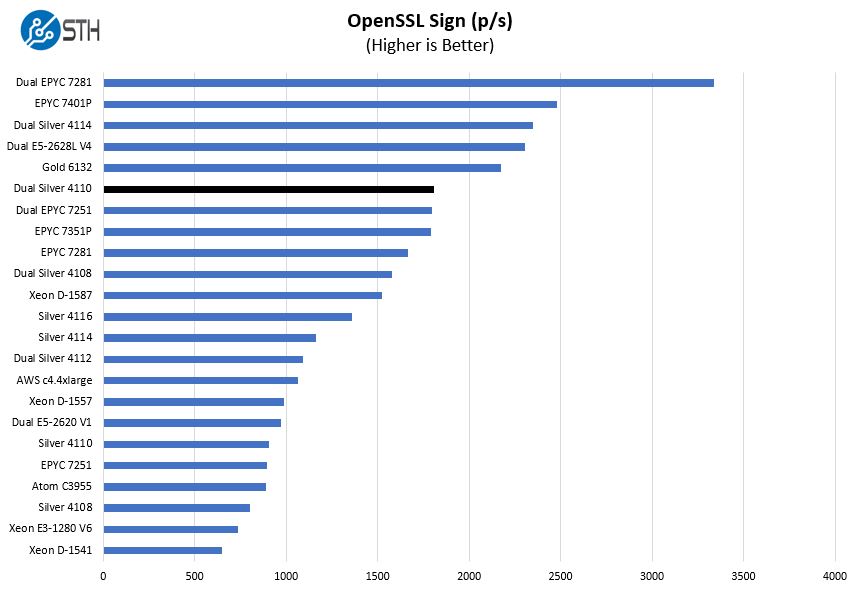
And the verify results:
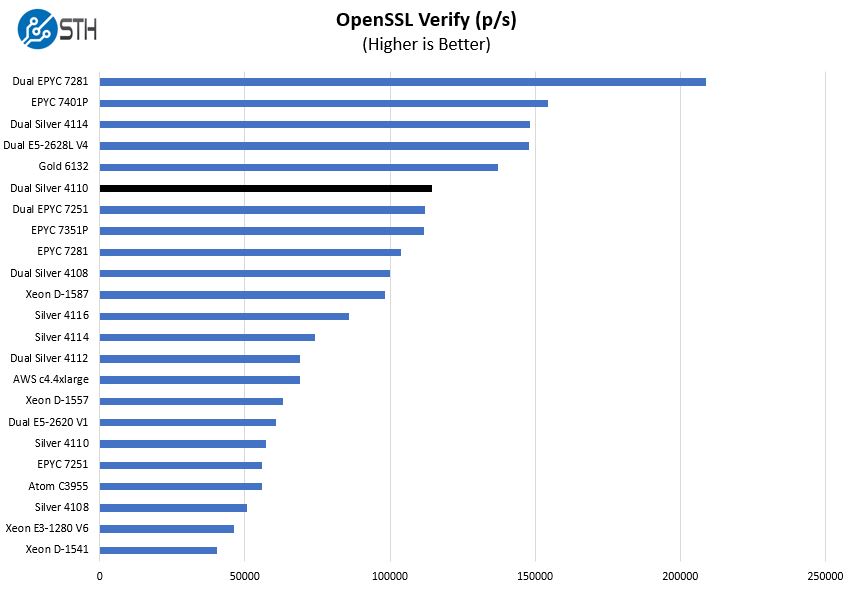
8-core to 8-core the dual Intel Xeon Silver 4110 and AMD EPYC 7251 configurations go head-to-head. Both are relatively similar in terms of cost yet the Intel Xeon Silver platform is noticeably lower power.
UnixBench Dhrystone 2 and Whetstone Benchmarks
Some of the longest-running tests at STH are the venerable UnixBench 5.1.3 Dhrystone 2 and Whetstone results. They are certainly aging, however, we constantly get requests for them, and many angry notes when we leave them out. UnixBench is widely used so we are including it in this data set. Here are the Dhrystone 2 results:
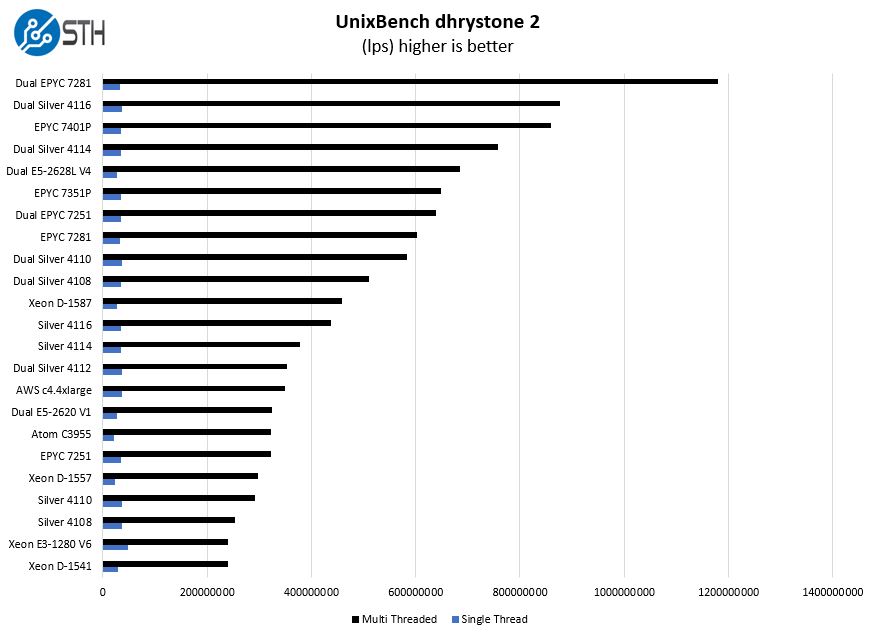
And the whetstone results:
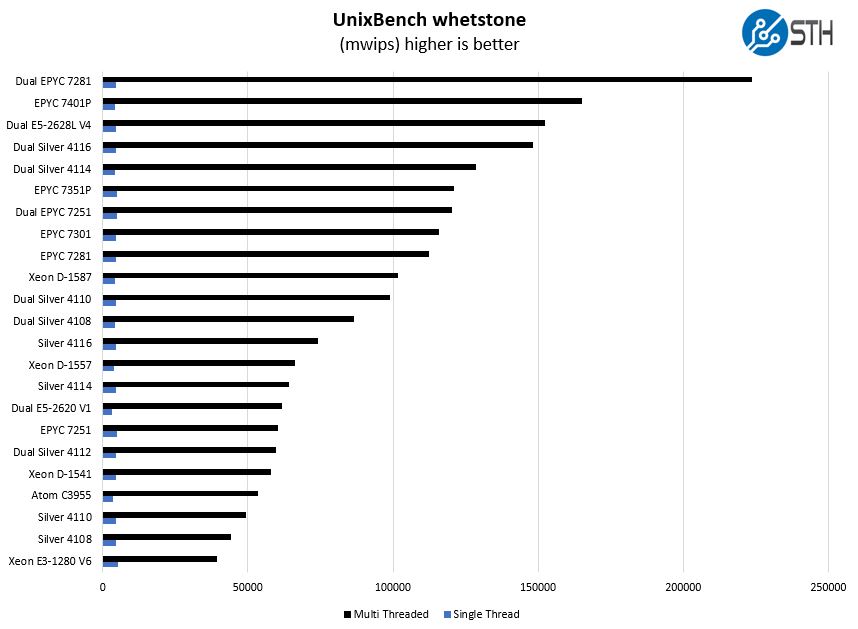
Performance here aligns with what we have seen with the chips and is about twice that of the single Intel Xeon Silver 4110 configuration.
GROMACS STH Small AVX2/ AVX-512 Enabled
We have a small GROMACS molecule simulation we previewed in the first AMD EPYC 7601 Linux benchmarks piece. In Linux-Bench2 we are using a “small” test for single and dual socket capable machines. Our medium test is more appropriate for higher-end dual and quad socket machines. Our GROMACS test will use the AVX-512 and AVX2 extensions if available.
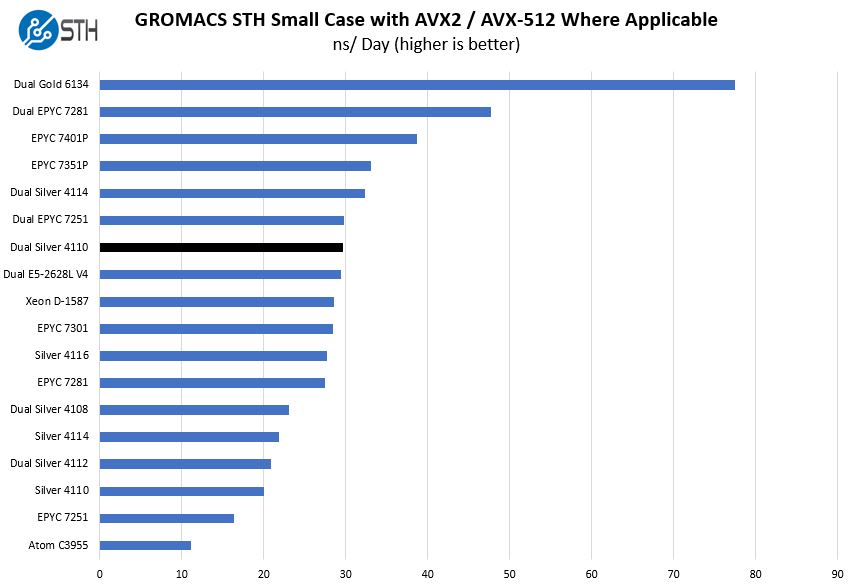
Here we can see very similar performance between the AMD and Intel offerings in this space even though Intel uses AVX-512. The dual Intel Xeon Gold 6134 results show what happens when the Intel architecture uses its dual-ported FMA unit as well as higher clock speeds. One can see the massive impact the fully implemented AVX-512 has on performance.
Chess Benchmarking
Chess is an interesting use case since it has almost unlimited complexity. Over the years, we have received a number of requests to bring back chess benchmarking. We have been profiling systems and are ready to start sharing results:
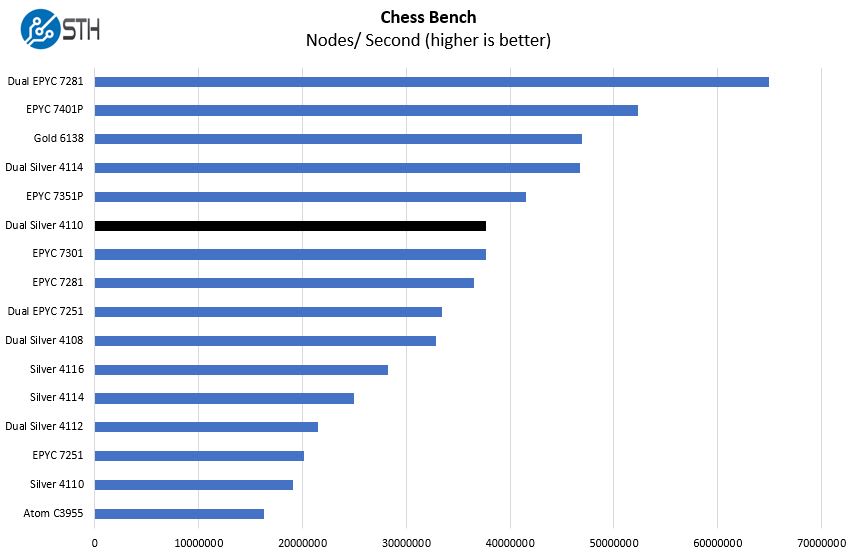
Here dual low power Intel Xeon Silver 4110 CPUs perform just about on par with the midrange AMD EPYC 7301 offering. One also gets a solid lift over the dual Intel Xeon Silver 4108 configuration.
A Note on Power Consumption
We wanted to post a few figures from our testing that show the real selling point of the chips, low power.
- Idle: 70W
- 70% Load: 174W
- 100% Load: 206W
- Peak: 211W
Note these results were taken using a 208V Schneider Electric / APC PDU at 17.8C and 72% RH. Our testing window shown here had a +/- 0.3C and +/- 2% RH variance. These are great power consumption figures. These are certainly solid results for this system and a large amount of the power is not used by the CPU and instead by the RAM and peripherals.
Market Positioning
Thes chips are not released in a vacuum instead, they have competition on both the Intel and AMD sides. When you purchase a server and select a CPU, it is important to see value of a platform versus its competitors.
2P Intel Xeon Silver 4110 v. Intel Xeon
In the world of Intel Xeon Silver the picture below the Intel Xeon Silver 4110 is easy while above the 4110 model is slightly confusing.
The question of whether one should upgrade from dual Silver 4108 to dual Silver 4110 CPUs is simply a cost/ benefit analysis of whether adding an incremental $200 or so to a configured server is worthwhile. In the context of a $4,800 base cost server which is the lower end for these configurations, the upgrade adds around 4%. That percentage goes down as the configuration goes up. Aside from single core performance where all Intel Xeon Silver CPUs are capped at 3.0GHz, this is a worthy upgrade.
Looking above the 4110 model number designation in the SKU stack is the Intel Xeon Silver 4112. The Silver 4112 is a 4 core / 8 thread model. Unless you are highly constrained by per core license costs, skip this CPU. The next real upgrade is the Intel Xeon Silver 4114 with 10 cores. On a low-end configuration, upgrading may cost another 10% for the server so one has to decide whether adding 12.5% more cores is necessary. If so, that is a good option to upgrade.
2P Intel Xeon Silver 4110 v. AMD EPYC
When we look at AMD EPYC, the other x86 architecture, the most direct comparison is the dual AMD EPYC 7251 configuration. Performance wise, dual AMD EPYC 7251 CPUs are relatively similar to the dual Intel Xeon Silver 4110 configuration. The Intel variant has better power consumption figures. Immediately upon taking the next step up the AMD EPYC ladder is the AMD EPYC 16 core line of the EPYC 7281, 7301 and 7351P. Intel and AMD generally trade blows in AMD single socket EPYC 16 core and Intel dual socket 8 core. AMD has a clear I/O advantage while Intel is optimized for power consumption.
Final Words
Overall, we really like the dual Intel Xeon Silver 4110. Assuming you have 12x 16GB DDR4 DIMMs, a dual socket server, two or three SSDs or hard drives in a server, the nominal cost to upgrade over the Silver 4108 is less than 5%. The question of whether one will go AMD largely rests on system availability as well as whether one wants higher power consumption and four NUMA nodes. When doing heavy I/O or deep learning / AI workloads, you generally want work on fewer NUMA nodes that Intel offers. Overall, in the Intel Xeon Silver range, as a general upgrade over the Intel Xeon E5-2620 V4 this is a great option.

